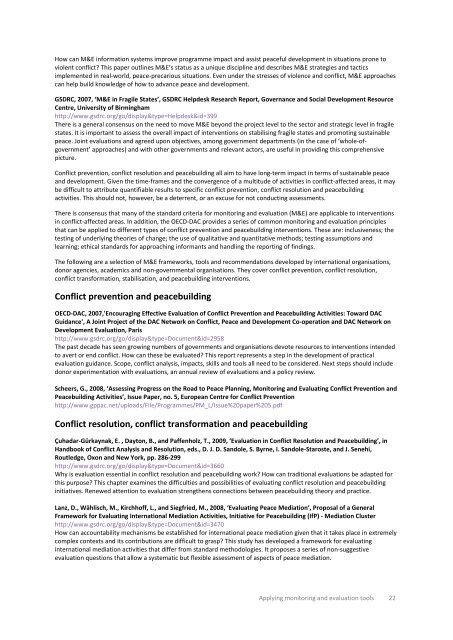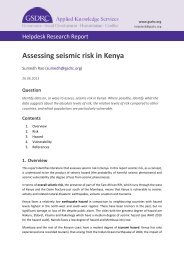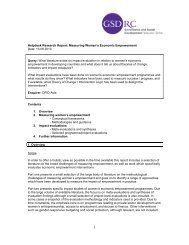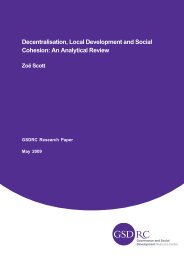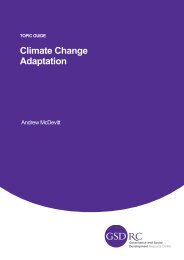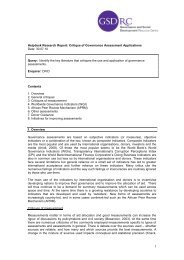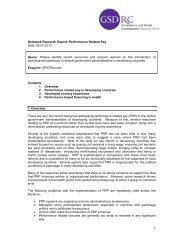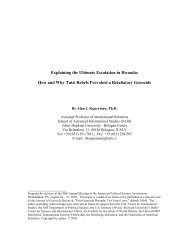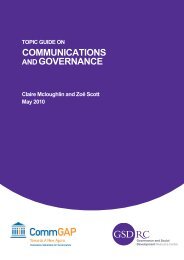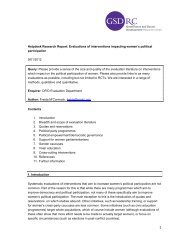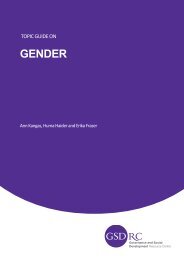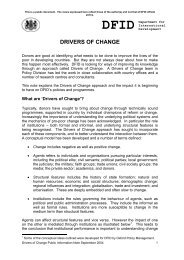PDF (28 pages; 360 KB) - GSDRC
PDF (28 pages; 360 KB) - GSDRC
PDF (28 pages; 360 KB) - GSDRC
You also want an ePaper? Increase the reach of your titles
YUMPU automatically turns print PDFs into web optimized ePapers that Google loves.
How can M&E information systems improve programme impact and assist peaceful development in situations prone toviolent conflict? This paper outlines M&E’s status as a unique discipline and describes M&E strategies and tacticsimplemented in real-world, peace-precarious situations. Even under the stresses of violence and conflict, M&E approachescan help build knowledge of how to advance peace and development.<strong>GSDRC</strong>, 2007, ‘M&E in Fragile States’, <strong>GSDRC</strong> Helpdesk Research Report, Governance and Social Development ResourceCentre, University of Birminghamhttp://www.gsdrc.org/go/display&type=Helpdesk&id=399There is a general consensus on the need to move M&E beyond the project level to the sector and strategic level in fragilestates. It is important to assess the overall impact of interventions on stabilising fragile states and promoting sustainablepeace. Joint evaluations and agreed upon objectives, among government departments (in the case of ‘whole-ofgovernment’approaches) and with other governments and relevant actors, are useful in providing this comprehensivepicture.Conflict prevention, conflict resolution and peacebuilding all aim to have long-term impact in terms of sustainable peaceand development. Given the time-frames and the convergence of a multitude of activities in conflict-affected areas, it maybe difficult to attribute quantifiable results to specific conflict prevention, conflict resolution and peacebuildingactivities. This should not, however, be a deterrent, or an excuse for not conducting assessments.There is consensus that many of the standard criteria for monitoring and evaluation (M&E) are applicable to interventionsin conflict-affected areas. In addition, the OECD-DAC provides a series of common monitoring and evaluation principlesthat can be applied to different types of conflict prevention and peacebuilding interventions. These are: inclusiveness; thetesting of underlying theories of change; the use of qualitative and quantitative methods; testing assumptions andlearning; ethical standards for approaching informants and handling the reporting of findings.The following are a selection of M&E frameworks, tools and recommendations developed by international organisations,donor agencies, academics and non-governmental organisations. They cover conflict prevention, conflict resolution,conflict transformation, stabilisation, and peacebuilding interventions.Conflict prevention and peacebuildingOECD-DAC, 2007,'Encouraging Effective Evaluation of Conflict Prevention and Peacebuilding Activities: Toward DACGuidance', A Joint Project of the DAC Network on Conflict, Peace and Development Co-operation and DAC Network onDevelopment Evaluation, Parishttp://www.gsdrc.org/go/display&type=Document&id=2958The past decade has seen growing numbers of governments and organisations devote resources to interventions intendedto avert or end conflict. How can these be evaluated? This report represents a step in the development of practicalevaluation guidance. Scope, conflict analysis, impacts, skills and tools all need to be considered. Next steps should includedonor experimentation with evaluations, an annual review of evaluations and a policy review.Scheers, G., 2008, ‘Assessing Progress on the Road to Peace Planning, Monitoring and Evaluating Conflict Prevention andPeacebuilding Activities’, Issue Paper, no. 5, European Centre for Conflict Preventionhttp://www.gppac.net/uploads/File/Programmes/PM_L/Issue%20paper%205.pdfConflict resolution, conflict transformation and peacebuildingÇuhadar-Gürkaynak, E. , Dayton, B., and Paffenholz, T., 2009, ‘Evaluation in Conflict Resolution and Peacebuilding’, inHandbook of Conflict Analysis and Resolution, eds., D. J. D. Sandole, S. Byrne, I. Sandole-Staroste, and J. Senehi,Routledge, Oxon and New York, pp. <strong>28</strong>6-299http://www.gsdrc.org/go/display&type=Document&id=3660Why is evaluation essential in conflict resolution and peacebuilding work? How can traditional evaluations be adapted forthis purpose? This chapter examines the difficulties and possibilities of evaluating conflict resolution and peacebuildinginitiatives. Renewed attention to evaluation strengthens connections between peacebuilding theory and practice.Lanz, D., Wählisch, M., Kirchhoff, L., and Siegfried, M., 2008, ‘Evaluating Peace Mediation’, Proposal of a GeneralFramework for Evaluating International Mediation Activities, Initiative for Peacebuilding (IfP) - Mediation Clusterhttp://www.gsdrc.org/go/display&type=Document&id=3470How can accountability mechanisms be established for international peace mediation given that it takes place in extremelycomplex contexts and its contributions are difficult to grasp? This study has developed a framework for evaluatinginternational mediation activities that differ from standard methodologies. It proposes a series of non-suggestiveevaluation questions that allow a systematic but flexible assessment of aspects of peace mediation.Applying monitoring and evaluation tools 22


